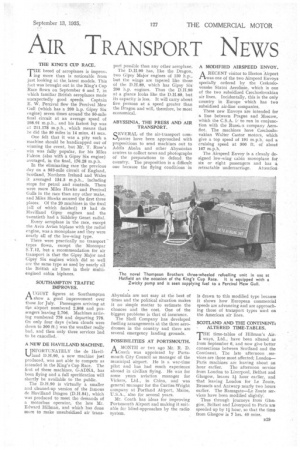AIR TRANSPORT NEWS
Page 39

If you've noticed an error in this article please click here to report it so we can fix it.
THE KING'S CUP RACE.
THE breed of aeroplanes is improving more than is noticeable from just looking at the, latest models. This fact was brought out in the King's Cup Race flown on September 6 and 7, in which familiar British aeroplanes made unexpectedly good speeds. Captain E. W. Percival flew the Percival Mew Gull (which has a 200 h.p. Gipsy Six engine) seven times around the 50-mile final circuit at an average speed of 208.91 m.p.h., and his fastest lap was at 211.178 m.p.h., which means that he did the 50 miles in 14 mins. 41 secs.
One felt that it was a pity such a machine should be handicapped out of winning the event, but Mr. T. Rose's win was fully popular, for his Miles Falcon (also with a Gipsy Six engine) averaged, in the final, 176.28 m.p.h.
In the eliminating race the previous day on a 953-mile circuit of England, Scotland, Northern Ireland and Wales it averaged 154.9 m.p.h., including stops for petrol and controls. There were more Miles Hawks and Percival Gulls in the race -than any other make, and Miles Hawks secured the first three places. Of the 20 machines in the final (all of which finished) 19 had de Havilland Gipsy engines and the twentieth had a Siddeley Genet radial.
Every aeroplane in the race, except the Avro Avian biplane with the radial engine, was a monoplane and they were nearly all of the low-wing type.
There were practically no transport types flown, except the Monospar S.T.12, but a recommendation for air transport is that the Gipsy Major and Gipsy Six engines which did so well are the same type as used by nearly all the British air lines in their multiengined cabin biplanes.
SOUTHAMPTON TRAFFIC IMPROVES.
A UGUST figures at Southampton
show a good improvement over those for July. Passengers arriving at the airport numbered 2,808 and passengers leaving 2,706. Machines arriving numbered 776 and departing 778. On only four days (when clouds were down to 300 ft.) was the weather really bad, and then only three services had to be cancelled.
A NEW DE HAVILLAND MACHINE.
UNFORTUNATELY the de Havilland D.H.90, a new machine jut produced, was not able to compete as intended in the King's Cup Race. The first of these machines, G-ADNA, has been flying and a full specification will shortly be available to the public.
The D.11.90 is virtually a smaller and cleaned-up version of the famous de Havilland Dragon (D.H.84), which was produced to meet the demands of a motorbus operator, the late Mr. Edward Hillman, and which has done more to make unsubsidized air trans
port possible than any other aeroplane.
The D.11.90 has, like the Dragon, two Gipsy Major engines of 130 h.p., but the wings are tapered like those of the D.H.89, which has Gipsy Six 200 h.p. engines. Thus the D.H.90 at a glance looks like the D.H.89, but its capacity is less. It will carry about five persons at a: speed greater than the Dragon and will, therefore, be most economical.
ABYSSINIA, THE PRESS AND AIR TRANSPORT.
SEVERAL of the air-transport companies have been approached with propositions to send machines out to Addis Ababa and other Abyssinian centres to collect news and photographs of the preparations to defend the country. The proposition is a difficult one because the flying conditions in
Abyssinia are not easy at the best of times and the political situation makes it no simple matter to estimate the chances and the cost, One of the biggest problems is that of insurance.
The Shell Company has developed fuelling arrangements at the three aerodromes in the country and there are several emergency landing grounds.
POSSIBILITIES AT PORTSMOUTH.
AMONTH or two ago Mr. R. D. oath was appointed by Portsmouth City Council as manager of the municipal airport. He is a war-time pilot and has had much experience abroad in civilian flying. He was for some years aviation manager for Vickers, Ltd., in China, and was general manager for the Curtiss-Wright company at Portland Airport, Maine, U.S.A., also for several years.
Mr. Coath has ideas for improving Portsmouth Airport and making it suitable for blind-approaches by the radio system. A MODIFIED AIRSPEED ENVOY.
ARECENT visitor to Heston Airport was one of the two Airspeed Envoys specially ordered by the Ceskoslovenske Statni Aerolinie, which is one of the two subsidized Czechoslovakian air lines. Incidentally, this is the only country in Europe which has two subsidized air-line companies.
These new Envoys are intended for a line between Prague and Moscow, which the C.S.A. i.-to run in conjunction with the Russi‘ra company Aeroflot. The machines have Czechoslovakian Walter Castor motors, which give a top speed of 191 m.p.h. and a cruising speed at 300 ft. of about 167 m.p.h.
The Airspeed Envoy is a cleanly designed low-wing cabin monoplane fox: six or eight passengers and has a, retractable undercarriage. Attention is drawn to this modified type because it shows how European commercial speeds are advancing and are approaching those of transport types used on the American air lines.
SCOTLAND AND THE CONTINENT: • ALTERED TIME-TABLES.
THE time-tables of Hillman's Airways,_ Ltd., have been altered as from September 6, and now give better connections between Scotland and the Continent. The late afternoon . services are those most affected; London— Paris machines are leaving about an
hour earlier. The afternoon service from London to Liverpool, Belfast and Glasgow, leaves l hour earlier, and that leaving London for Le Zoute, Brussels and Antwerp nearly two hours earlier. The Ramsgate—Le Zonte services have been modified slightly'.
Thus through journeys from Glasgow, Belfast and Liverpool to Paris are speeded up by 11 hour, so that the time from Glasgow is 7 hrs. 40 mins,




















































































